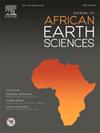Adaptive utilization of Castagna and Biot-Gassmann equations in fluid replacement mechanism (FRM), with elastic logs analysis and petrophysical cross-plots for fluid discrimination in an offshore basin, Niger Delta, Nigeria
IF 2.2
4区 地球科学
Q2 GEOSCIENCES, MULTIDISCIPLINARY
引用次数: 0
Abstract
Determination of reservoir fluid type is a useful basic procedure in reservoir fluid characterization. Among the ways to achieve this, are through elastic logs and cross plotting in conjunction with fluid replacement mechanism (FRM) which have the capability to discriminate one fluid type from another thereby removing - uncertainties and ambiguity from the reservoir fluid interpretation and isolation. The aim of the study was to accurately identify hydrocarbon and distinguishes it from the brine. This was achieved through elastic log cross-plotting and fluid substitution with clear objectives of diagnosing various reservoir fluid content, removing ambiguities, clearing uncertainties and reducing risks. The novelty in this study lies in its ability to combine the sophisticated fluid identification templates by employing different parameterization approaches including the use of bulk modulus of the rock matrix, dry rock, fluid, and saturated rock frame. It also involved the utilization of reservoir porosity, saturated rigidity modulus, dry-rock shear modulus and densities. Elastic logs were generated from the P-wave (Vp), S-wave (Vs) and density (ρ) logs and was followed by cross plotting to determine the fluid zones within the field. Castagna and Biot-Gassmann equations were utilised for the replacement mechanism to identify the nature of fluid present in each of the reservoirs. Findings from the study revealed the presence of hydrocarbon within the field as indicated by the low values of elastic logs such P-impedance (Zp), S-impedance (Zs), Vp/Vs ratio, Lambda-Rho (λρ) and Mu-Rho (μρ) and their cross plots. The hydrocarbon-bearing intervals were isolated in the cross plot space while the reservoir saturated with brine and shaly units formed the background effect. Also, the result of fluid replacement techniques revealed that the reservoirs with hydrocarbon as insitu fluid developed a new log response tracking the original insitu log when the insitu fluid was replaced with hydrocarbon except at the water bearing intervals where the log departed from the path of tracking each other. But the new log deviated from the insitu original log when the insitu fluid was replaced with brine at the oil and gas zones. Again when the reservoir insitu fluid was brine and substituted with brine, the new modified log also tracked the original insitu log except at hydrocarbon intervals where it deviated. The FRM categorically characterised the fluids and confirmed the interpretation from both elastic log and cross plot and all the results corroborated well. The significance of the study is the delineation of hydrocarbon-charged intervals and characterization of various reservoir fluids Therefore, elastic logs, cross plot and FRM served as important means of fluid isolation and discrimination in AbdulBaari-Field. The techiques holds the potential to solve similar problems in any hydrocarbon field in different parts of the world
利用Castagna和Biot-Gassmann方程在流体替代机制(FRM)中的自适应应用,结合弹性测井分析和岩石物理交叉图进行尼日利亚尼日尔三角洲海上盆地流体识别
储层流体类型的确定是储层流体表征的一个有用的基本步骤。实现这一目标的方法之一是通过弹性测井和与流体替代机制(FRM)相结合的交叉绘图,该机制能够区分一种流体类型,从而消除储层流体解释和隔离中的不确定性和模糊性。这项研究的目的是准确地识别碳氢化合物,并将其与盐水区分开来。这是通过弹性测井交叉绘图和流体替代实现的,目标明确,可以诊断各种储层流体含量,消除模糊性,消除不确定性,降低风险。本研究的新颖之处在于,它能够通过采用不同的参数化方法,包括使用岩石基质、干岩、流体和饱和岩石框架的体积模量,将复杂的流体识别模板结合起来。它还涉及到储层孔隙度、饱和刚度模量、干岩剪切模量和密度的利用。弹性测井由纵波(Vp)、横波(Vs)和密度(ρ)测井生成,然后进行交叉绘图以确定油田内的流体区域。利用Castagna方程和Biot-Gassmann方程来确定每个储层中存在的流体性质。p -阻抗(Zp)、s -阻抗(Zs)、Vp/Vs、λ - ρ (λρ)和mu - ρ (μρ)等弹性测井曲线的低值及其交叉图表明,油田内存在油气。含油气层段在交叉圈定空间中被隔离,而储层中盐水和泥质单元的饱和形成了背景效应。此外,流体替代技术结果表明,除含水层段测井曲线偏离轨迹外,以油气为原位流体的储层在采用油气替代原位流体后,形成了一种新的测井响应,可以跟踪原始的原位测井曲线。但在油气区用卤水代替原位流体后,新测井曲线与原位原始测井曲线出现偏差。同样,当储层原位流体为盐水并用盐水代替时,除了油气层段发生偏移外,新的修正测井曲线也能跟踪原始的原位测井曲线。FRM对流体进行了分类描述,并证实了弹性测井和交叉图的解释,所有结果都得到了很好的证实。该研究的意义在于油气充注层段的圈定和各种储层流体的表征,因此,弹性测井、交叉图和FRM是abdulbaari油田流体隔离和识别的重要手段。这些技术有可能解决世界不同地区任何油气田的类似问题
本文章由计算机程序翻译,如有差异,请以英文原文为准。
求助全文
约1分钟内获得全文
求助全文
来源期刊

Journal of African Earth Sciences
地学-地球科学综合
CiteScore
4.70
自引率
4.30%
发文量
240
审稿时长
12 months
期刊介绍:
The Journal of African Earth Sciences sees itself as the prime geological journal for all aspects of the Earth Sciences about the African plate. Papers dealing with peripheral areas are welcome if they demonstrate a tight link with Africa.
The Journal publishes high quality, peer-reviewed scientific papers. It is devoted primarily to research papers but short communications relating to new developments of broad interest, reviews and book reviews will also be considered. Papers must have international appeal and should present work of more regional than local significance and dealing with well identified and justified scientific questions. Specialised technical papers, analytical or exploration reports must be avoided. Papers on applied geology should preferably be linked to such core disciplines and must be addressed to a more general geoscientific audience.
 求助内容:
求助内容: 应助结果提醒方式:
应助结果提醒方式:


